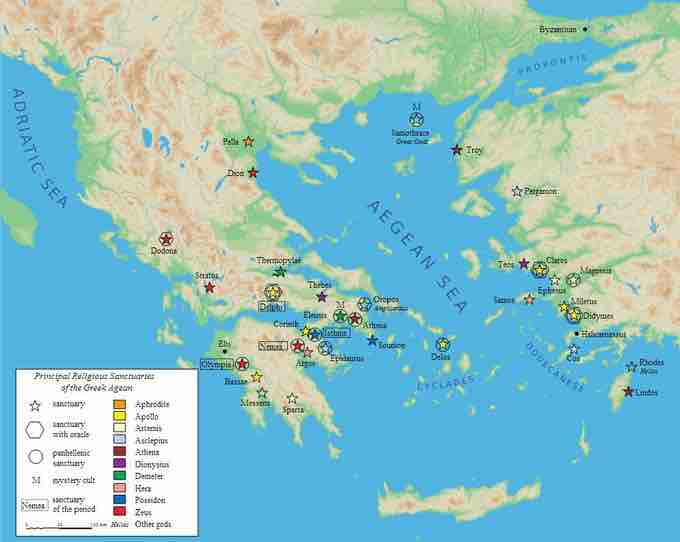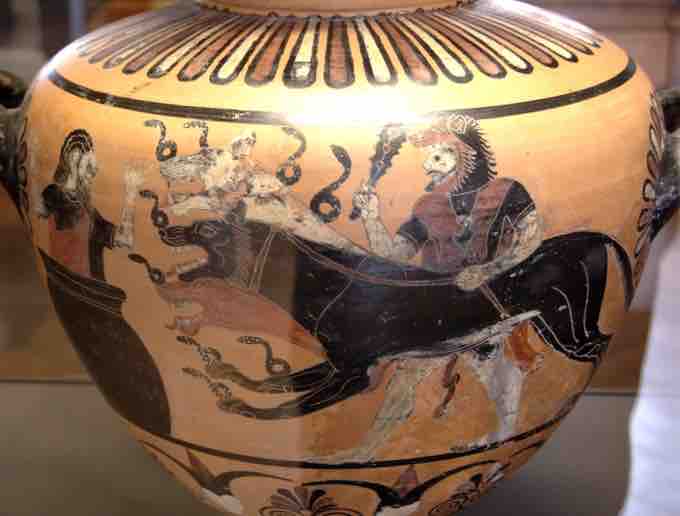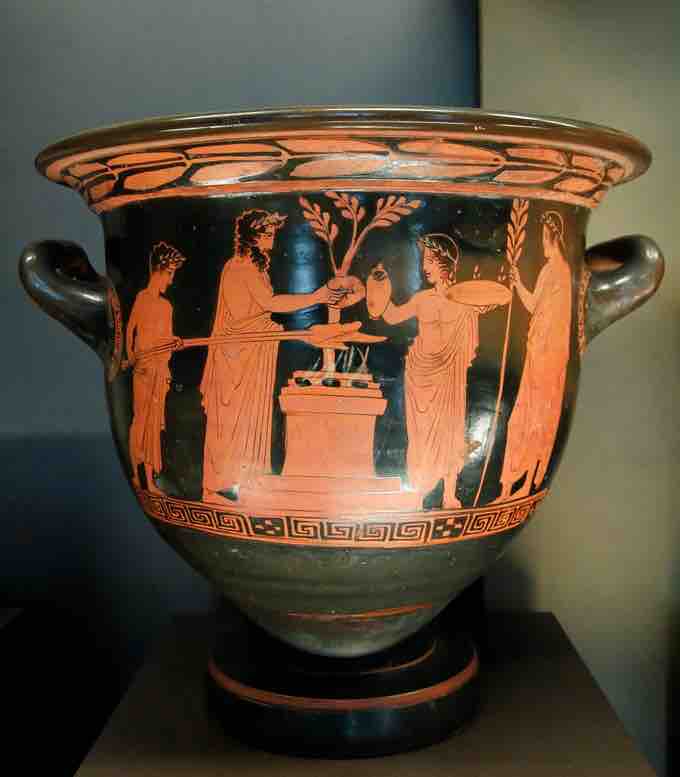Greek religious traditions encompassed a large pantheon of gods, complex mythologies, rituals, and cult practices. Greece was a polytheistic society, and looked to its gods and mythology to explain natural mysteries as well as current events. Religious festivals and ceremonies were held throughout the year, and animal sacrifice and votive offerings were popular ways to appease and worship the gods. Religious life, rituals, and practices were one of the unifying aspects of Greece across regions and poleis (cities, or city-states, such as Athens and Sparta).

Principal Religious Sanctuaries of the Greek Aegean
Gods
Greek gods were immortal beings who possessed human-like qualities and were represented as completely human in visual art. They were moral and immoral, petty and just, and often vain. The gods were invoked to intervene and assist in matters large, small, private and public. City-states claimed individual gods and goddess as their patrons. Temples and sanctuaries to the gods were built in every city. Many cities became cult sites due to their connection with a god or goddess and specific myths. For instance, the city of Delphi was known for its oracle and sanctuary of Apollo, because Apollo was believed to have killed a dragon that inhabited Delphi.
The history of the Greek pantheon begins with the primordial deities Gaia (Mother Earth) and Uranus (Father Sky), who were the parents of the first of twelve giants known as Titans. Among these Titans were six males -- Oceanus, Hyperion, Coeus, Crius, Iapetus, and Kronos -- and six females -- Themis, Mnemosyne, Tethys, Theia, Phoebe, and Rhea. Kronos eventually overthrew Uranus and ruled during a mythological Golden Age. Over time, he and Rhea had twelve children who would become the Olympian gods. However, Kronos heard a prophecy that his son would overthrow him, as he did to Uranus. In an effort to avert fate, he ordered Rhea to allow him to devour each of the children upon their birth.
Themis
One of the first 12 Titans, Themis was the personification of divine law, as opposed to human ordinance.
Best known among the pantheon are the twelve Olympian gods and goddesses who resided on Mt. Olympus in northern Greece. Zeus, the youngest son of Rhea and Kronos, was hidden from his father, instead of being swallowed. Once he became a man, he challenged his father's rule, forcing Kronos to regurgitate the rest of his swallowed children. These children were Zeus's siblings, and together they overthrew Kronos, making Zeus the father of gods and men. Violence and power struggles were common in Greek mythology, and the Greeks used their mythologies to explain their lives around them, from the change in seasons to why the Persians were able to sack Athens.
The traditional pantheon of Greek gods includes Zeus, the king of gods and the ruler of the sky; his two brothers, Poseidon (who ruled over the sea) and Hades (who ruled the underworld). It also includes Zeus's sister and wife, Hera, the goddess of marriage, frequently jealous and vindictive of Zeus's other lovers; their sisters Hestia, the goddess of the hearth, and Demeter, the goddess of grain and culture. Additionally, Zeus's children, including Athena (goddess of warfare and wisdom), Hermes (a messenger god and god of commerce), the twins Apollo (god of the sun, music, and prophecy) and Artemis (goddess of the hunt and of wild animals), Dionysos (god of wine and theatre), Aphrodite (goddess of beauty and love), who was married to Hephaestus (deformed god of the forge), and Ares (god of war and lover of Aphrodite) are also part of the traditional pantheon. Hephaestus was in some mythologies the son of Zeus while in others the fatherless son of Hera.
Praxiteles. Hermes and the Infant Dionysos.
Here, Hermes cares for the now motherless Dionysos. Originally, Hermes held a bunch of grapes, with which he teased the infant god of wine. c. 4th century BCE.
Heroes
Heroes, who were often demigods, were also important characters in Greek mythology. The two most important heroes are Perseus and Hercules. Perseus is known for defeating the Gorgon, Medusa. He slew her with help from the gods: Athena gave him armor and a reflective shield, and Hermes provided Perseus with winged sandals so he could fly. Hercules was a strong but unkind man, a drunkard who conducted huge misdeeds and social faux pas. Hercules was sent on twelve labors to atone for his sins as punishment for his misdeeds. These deeds, and several other stories, were often depicted in art, on ceramic pots, or on temple metopes. The most famous of his deeds include slaying both the Nemean Lion and the Hydra, capturing Cerberus (the dog of the underworld) and obtaining the apples of the Hesperides. A third hero, Theseus, was an Athenian hero known for slaying King Minos's Minotaur. Other major heros in Greek mythology include the warriors and participants of the Trojan War, such as Achilles, Ajax, Odysseus, Agamemnon, Paris, Hector, and Helen. Hero cult was another popular form of Greek worship that involved the honoring of the dead, specifically the dead heroes of the Trojan War. The sites of hero worship were usually old Bronze Age sites or tombs that the ancient Greeks recognized as important or sacred, which they then connected to their own legends and stories.

Hercules and Cerberus.
Eagle Painter. Hercules bringing Cerberus back to King Eurystheus. Black figure hydra. c. 525 BCE.
Sacred Spaces
Greek worship was centered on the temple. The temple was considered the home of the god, and a cult statue of the god would be erected in the central room, or the naos. Temples generally followed the same basic rectangular plan, although a round temple, known as a tholos, were used at some sites in starting in the Classical period. Temples were oriented east to face the rising sun. Patrons would leave offerings for the gods, such as small votives, large statues, libations or costly goods. Due to the wealth dedicated to the gods, the temples often became treasuries that held and preserved the wealth of the city. Greek temples would be extensively decorated, and their construction was a long and costly endeavor. Rituals and animal sacrifices in honor of the god or goddess would take place outside, in front of the temple. Rituals often included a large number of people, and sacrifice was a messy business that was best done outdoors. The development and decoration of temples is a primary focus in the study of Greek art and culture.

Sacrificial Scene
Pothos Painter. Scene of a sacrifice. Attic red-figure bell krater. Ca. 430-420 BCE. Athens, Greece.